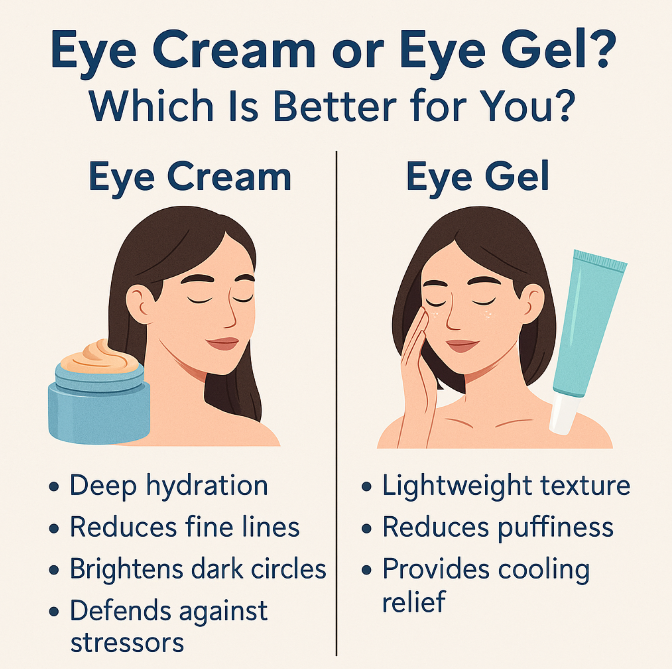
When it comes to skincare, few areas are as tricky as the delicate skin beneath your eyes. With endless products flooding the beauty aisles, you’ve probably wondered: Should I choose an eye cream or an eye gel? Both promise smoother, brighter under-eyes, but they work differently depending on your skin type, age, and needs. Let’s break down the differences, benefits, and how to make the right choice for your skincare routine.
Understanding the Importance of Under-Eye Care
The skin under your eyes is thinner and more fragile than the rest of your face. It lacks oil glands, making it more prone to dryness, fine lines, puffiness, and dark circles. On top of that, lifestyle factors like lack of sleep, stress, and screen time only make things worse. This is why dermatologists often stress the need for a targeted product—either a nourishing cream or a lightweight gel—to keep the area healthy and youthful.
Eye Cream: Deep Hydration and Anti-Aging Power
Eye creams are rich, emollient formulas designed to deliver intense hydration. Think of them as a glass of water for your under-eye skin—but with added nutrients. These creams often contain vitamins C and E, fatty acids, and botanical extracts like quinoa seed extract, which help to plump, smooth, and brighten.
- Fights premature aging by reducing fine lines, crow’s feet, and sagging
- Hydrates dry and tight under-eye skin
- Brightens dark circles caused by fatigue or genetics
- Shields delicate skin from pollution and UV damage
If you’re in your 20s, starting with an eye cream is a smart investment. Don’t wait until wrinkles appear—preventing them is far easier than reversing them.
Video : Eye Cream vs Eye Gel Which Is Better?
Eye Gel: Lightweight, Cooling Relief
Eye gels are water-based formulas with a refreshing texture. Unlike creams, they aren’t heavy or oily, making them ideal for people who dislike thick products. Their biggest strength? They cool, soothe, and de-puff tired eyes almost instantly.
- Perfect for oily or combination skin
- Reduces puffiness with cooling relief
- Provides a quick fix for tired eyes after long nights
- Creates a temporary tightening effect for a firmer look
If you’re younger and mostly deal with puffiness or occasional tired eyes, an eye gel may be all you need.
Which One Should You Choose?
The answer depends on your skin type, age, and concerns.
Choose an eye cream if:
- You’re worried about fine lines or early signs of aging
- You have dry or dehydrated skin
- You want long-term anti-aging benefits
Choose an eye gel if:
- You have oily or combination skin
- You’re younger and just need light hydration
- You struggle with puffiness more than wrinkles
Many people even use both: a cream at night for repair and a gel in the morning for instant refreshment.
How to Apply Under-Eye Products Correctly
It’s not just what you use—it’s how you use it. The under-eye area is extremely delicate, so a gentle touch is key.
- Use your ring finger to apply the product.
- Dab a pea-sized amount evenly under the eyes.
- Pat gently—never rub—until absorbed.
- Apply morning and night for best results.
During the day, ingredients like Vitamin C protect against damage from sun and pollution. At night, creams and gels work while you sleep, encouraging repair and renewal.
Video : 3 Best Under Eye Creams for Dark Circles & Eye Bags
The Bottom Line: Cream or Gel?
Both eye creams and eye gels can transform your under-eye area. If you want deep hydration and anti-aging power, reach for a cream. If you prefer lightweight freshness and de-puffing benefits, go with a gel. The best choice is the one that matches your skin’s needs and lifestyle.
Healthy, radiant under-eyes not only make you look more refreshed but also boost your confidence. Whether you use cream, gel, or both, consistency is the secret to achieving long-lasting results.


